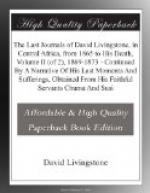Chiwe presented a small goat with crooked legs and some millet flour, but he grumbled at the size of the fathom cloth I gave. I offered another fathom, and a bundle of needles, but he grumbled at this too, and sent it back. On this I returned his goat and marched.
[The road lay through the same country among low hills, for several miles, till they came on the 1st December to a rivulet called Lovu Katanta, where curiously enough they found a nutmeg-tree in full bearing. A wild species is found at Angola on the West Coast and it was probably of this description, and not the same species as that which is cultivated in the East. In two places he says:—]
Who planted the nutmeg-tree on the Katanta?
[Passing on with heavy rain pouring down, they now found themselves in the Wemba country, the low tree-covered hills exhibiting here and there “fine-grained schist and igneous rocks of red, white, and green colour.”]
3rd December, 1872.—No food to be got on account of M’toka’s and Tipo Tipo’s raids.
A stupid or perverse guide took us away to-day N.W. or W.N.W. The villagers refused to lead us to Chipwite’s, where food was to be had; he is S.W. 1-1/2 day off. The guide had us at his mercy, for he said, “If you go S.W. you will be five days without food or people.” We crossed the Kanomba, fifteen yards wide, and knee deep. Here our guide disappeared, and so did the path. We crossed the Lampussi twice; it is forty yards wide, and knee deep; our course is W.N.W. for about 4-1/2 hours to-day. We camped and sent men to search for a village that has food. My third barometer (aneroid) is incurably injured by a fall, the man who carried it slipped upon a clayey path.
4th December, 1872.—Waiting for the return of our men in a green wooded valley on the Lampussi River. Those who were sent yesterday return without anything; they were directed falsely by the country people, where nought could be bought. The people themselves are living on grubs, roots, and fruits. The young plasterer Sphex is very fat on coming out of its clay house, and a good relish for food. A man came to us demanding his wife and child; they are probably in hiding; the slaves of Tipo Tipo have been capturing people. One sinner destroyeth much good!
5th December, 1872.—The people eat mushrooms and leaves. My men returned about 5 P.M. with two of Kafimbe’s men bringing a present of food to me. A little was bought, and we go on to-morrow to sleep two nights on the way, and so to Kafimbe, who is a brother of Nsama’s, and fights him.
6th December, 1872.—We cross the Lampussi again, and up to a mountain along which we go, and then down to some ruins. This took us five hours, and then with 2-1/4 more hours we reach Sintila. We hasten along as fast as hungry men (four of them sick) can go to get food.
1th December, 1872.—Off at 6.15 A.M. A leopard broke in upon us last night and bit a woman. She screamed, and so did the donkey, and it ran off. Our course lay along between two ranges of low hills, then, where they ended, we went by a good-sized stream thirty yards or so across, and then down into a valley to Kafimbe’s.




